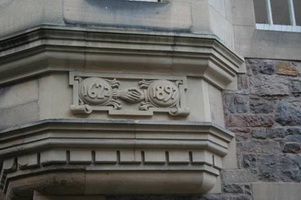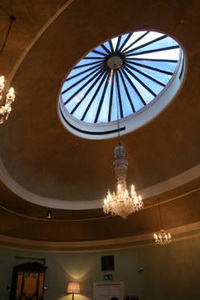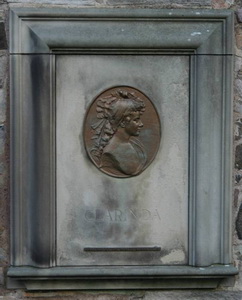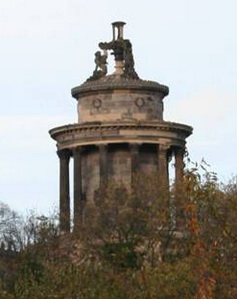One afternoon in late October “a merry core o’ randie gangrel bodies” convened with Charlie Milne QPM in the Grassmarket to be led on a tour of places in the capital associated with Burns’ various visits to Edinburgh.

Charlie commences his tour
Charlie’s extensive knowledge of both Burns and Edinburgh made for an interesting afternoon. From the Grassmarket we made our way into Victoria Street and onto the Lawnmarket where we were led down many closes into the little known back-courts of the Old Town.

Restored masonry work in the Old Town

Anchor Close – site of the office of William Creech, Burns’ publisher
Crossing over past St. Giles we descended to the Cowgate to visit St. Cecilia’s hall where Burns attended many recitals. The restored ceiling and collection of antique instruments made this a worthwhile stop on the tour.

Ceiling of St. Cecilia’s Hall
Towards the end of the tour we found ourselves in the Canongate Kirkyard surrounded by the ornate tombs of the great and guid of Auld Edinburgh

The spectacular skyline from the Canongate Kirkyard

The Royal High School and Nelson’s Monument on Calton Hill
Due to major restoration work we were unable to see the headstone on the grave of Robert Fergusson, paid for by Burns, but on a opposite wall the bronze plaque in memory of Agnes (Nancy) Maclehose still shows the profile of the woman that enchanted Burns and inspired one of his greatest songs.

But to see her was to love her
Above on the skyline we could also see the Burns Monument, now fully restored. There are plans to replant the gardens around the monument with every plant and flower mentioned in the Bard’s works.

The Burns Monument of Regent Terrace
Charlie’s finally spent some time talking about on Robert Fergusson, this, aptly taking place beside the statue of the poet at the gate of the kirkyard. His death brought to a tragically premature end a short, but highly accomplished and extremely promising literary career. Fergusson’s poems were collected and published the year after his death and became an immediate success.
Many of Robert Burns’ poems were clearly inspired by Fergusson’s work and, when Burns visited Edinburgh in 1787, he paid for the erection of the headstone in the Kirkyard to the man he described as “Scotia’s Poet”. He also wrote the inscription, which reads:
No sculptur’d Marble here, nor pompous lay,
‘No storied Urn nor animated Bust;’
This simple stone directs pale SCOTIA’S way
To pour her sorrow o’er the POET’S dust.

A fine poet and songwriter with Robert Ferguson
As the day waned we made our way back up the Canongate, into Infirmary Street and closed our afternoon with a small libation taken in the Royal Oak.

Jimmie Dunbar looks dubious at the thought of ever getting a drink out of Jim Weatherston
Much discussion took place about the sights we had seen and a vote of thanks was proposed to Charlie Milne for his generosity in hosting the tour and for giving us the benefit of his encyclopaedic knowledge of Robert Burns’ time in Edinburgh.
RETURN to the Top
